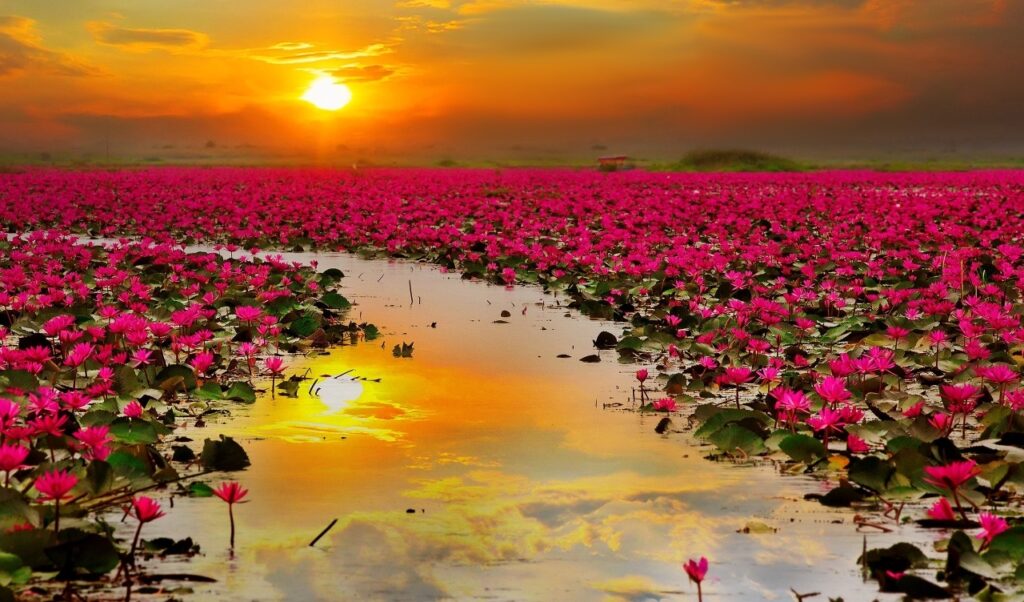Isan, a region of Thailand off the beaten track, which deserves to take the time to visit...
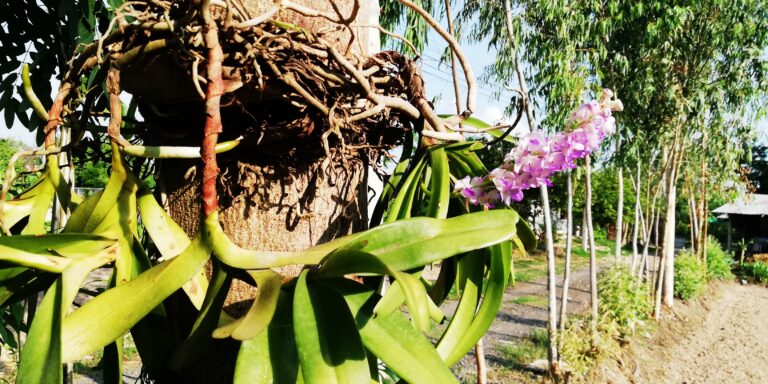
Hello everyone! Today I’m going to tell you about Isan, a fascinating region of Thailand, located in the northeast of the country. Isan is known for its rich and diverse culture, influenced by Laos, Cambodia and China. It is also where the majestic Mekong River flows, which crosses six Asian countries and offers breathtaking landscapes. Isan is an ideal destination for curious and eager travelers. Come with me to explore this land of contrasts and traditions!
Contrary to what one might think, Isan is not a rural and monotonous desert. It is a region that moves, that lives, that offers all the amenities and attractions you can dream of. Whether you are attracted by modern and lively cities, or by natural and authentic landscapes, you will find your account in Isan. Modern hospitals, transport, roads, leisure, hotels, shopping centers, tourist sites, national parks,… there is everything you need…
To fully enjoy your stay in Isan, it is better to be autonomous and rent a vehicle, whether it is a car or a motorcycle. This way, you can explore the most interesting sites at your own pace, without depending on public transport or organized tours.
Now, if you prefer sunbathing and diving, I advise you to choose rather the south of Thailand… … No? Then it’s this way!
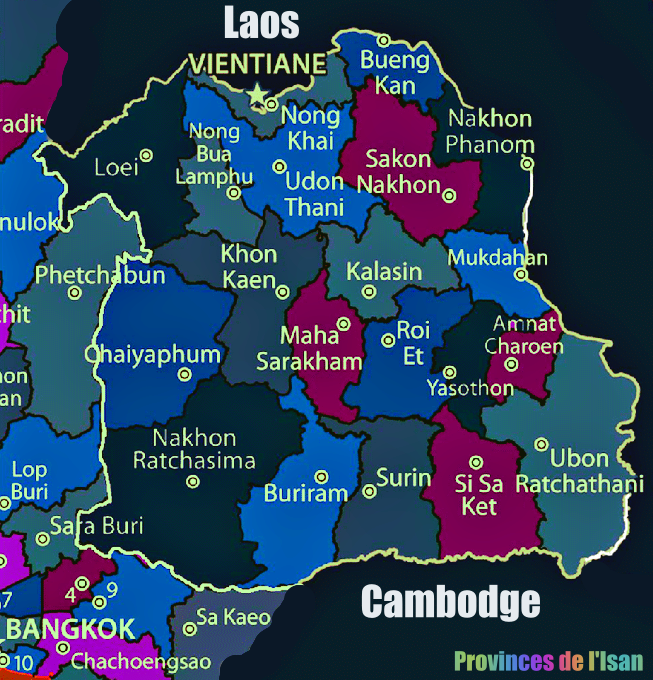
The cities of Isan are rich in history, traditions and natural beauty. They offer visitors a glimpse of an authentic and peaceful way of life, far from the hustle and bustle of big metropolises. Each of these cities have their own charm and attractions to discover. We will briefly introduce you to a selection of extraordinary sites and make you want to explore them in more detail.
We will start our route with the province of Nakhon Ratchasima
Nakhon Ratchasima is a city in northeastern Thailand, also called Khorat. It is the largest province in the Isan region and an important historical, economic and cultural center. The city has many Khmer remains, witnesses of its glorious past, as well as varied natural landscapes, such as the Khao Yai National Park. Nakhon Ratchasima is also known for its local heroine, Thao Suranari, who resisted the invasion of the Vientiane army in 1826.
- Khao Yai National Park... 😍 Favorite destination 😍
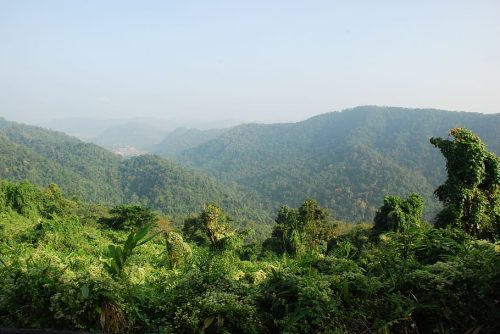
Khao Yai National Park is a natural gem in Thailand. It extends over more than 2000 km² and is home to exceptional biodiversity. You can observe elephants, leopards, gibbons, hornbills and many other animal and plant species. The park also offers magnificent landscapes, with forests, mountains and waterfalls. It is the first national park created in Thailand and is a UNESCO World Heritage Site.
The park is open all year round, but the best time to visit is from November to February, when the climate is cooler and drier. The entrance fee is 400 baht per person for foreigners and 40 baht for Thais.
- The Phimai Historical Park
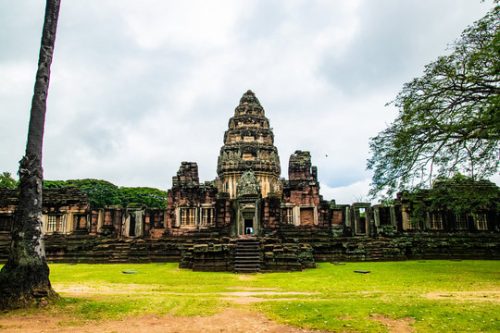
Phimai Historical Park is an archaeological site located in Nakhon Ratchasima province, Thailand. It houses the ruins of an ancient Khmer temple dedicated to Shiva, built between the 11th and 12th centuries. Phimai Historical Park is one of the largest and finest examples of Khmer art and architecture in Thailand.
The park is open every day from 8 a.m. to 6 p.m. The entrance fee is 100 baht for foreigners and 20 baht for Thais.
- Sai gnam, Phimai
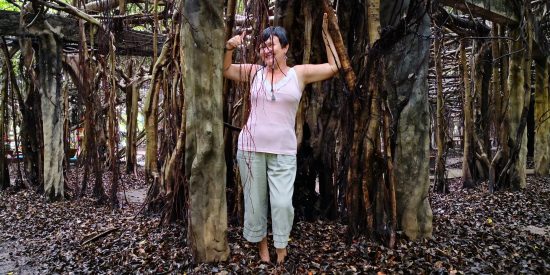
Sai Ngam is a park located 2 km south of downtown Phimai, Thailand. It is home to what is said to be the largest and oldest banyan tree in Asia, at 350 years old. Its roots and branches have created a real forest in which you can walk in the shade of the vaults they form. The park is surrounded by a pond where the sky and clouds are reflected, as well as pink flamingo figurines. It is a sacred place where there are many small temples.
The best time to visit Sai Gnam and Phimai is from November to February, when the climate is cooler and drier.
Khon Kaen province
Khon Kaen Province is a region located in the northeast of Thailand. It is part of the Khorat plateau and is bordered by the Mekong to the north. Its capital is the town of Khon Kaen, which is an important cultural and economic center. The province is known for its production of silk, rice, and fruits.
- Sala Mai Thai
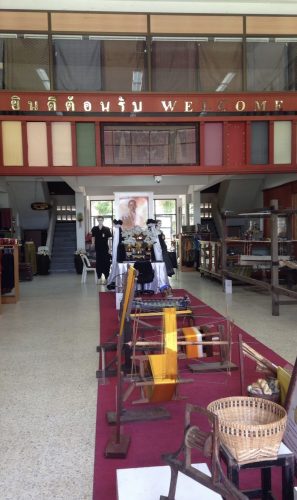
Sala Mai Thai is a silk museum located in Khon Kaen Vocational College, Thailand. It is part of a project to celebrate Queen Sirikit’s 60th birthday (August 12, 1992) and to promote silk and silk products from Isan (northeast Thailand), as well as to conserve the traditions. The museum showcases the history, culture and techniques of silk making, as well as exhibits of royal costumes and ancient textiles.
The Sala Mai Thai houses the oldest tapestry in Thailand, which dates from the reign of King Rama V (1868-1910). It depicts scenes from daily life and legends of the Thai people. The tapestry measures 2 meters wide and 72 meters long, and was restored in 1992 with the help of Queen Sirikit.
The museum is open Tuesday to Sunday, 9 a.m. to 5 p.m. Entrance is free for visitors.
- Wat Nong Wang

The Phra Mahathat Kaen Nakhon, Wat Nong Wang is a Buddhist temple located in Khon Kaen, northeastern Thailand. It is famous for its nine-story stupa, called Phra Mahathat Kaen Nakhon, which was built in 1996 to commemorate the 50th anniversary of the reign of King Bhumibol Adulyadej and the 200th anniversary of the city of Khon Kaen. Each floor of the stupa features elements of the region’s culture, history and religion, as well as colorful murals and mosaics depicting animals. The stupa also offers panoramic views of the lake and the city. Wat Nong Wang is a must-visit place for visitors who want to discover the artistic and spiritual heritage of Khon Kaen.
- Bueng Kaen Nakhon lake
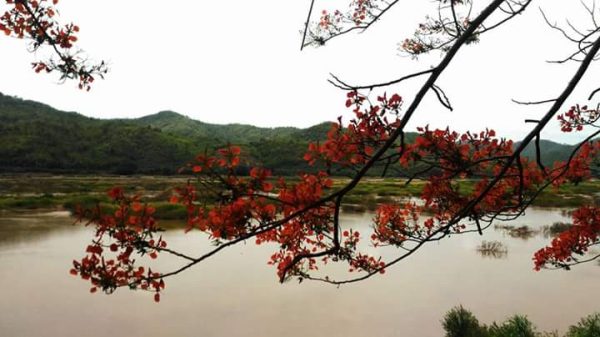
Bueng Khan Nakhon Lake, is a magnificent natural site located in Khon Kaen province, and in the city center of Khon Kaen city, it is home to a great diversity of flora and fauna. Bueng Khan Nakhon Lake is also a place of relaxation and recreation for locals and tourists. You can go kayaking, cycling, jogging or simply admire the landscape.
Loei province
Loei Province is a region in northeastern Thailand, located on the border with Laos. It is known for its cool climate, mountainous landscapes and cultural richness. Loei Province offers many tourist attractions, such as Phu Kradueng National Park, Huai Krating Reservoir and Wat Tham Pha Pu Temple. Loei province is also renowned for its local gastronomy, which mixes Thai, Laotian and Chinese influences.
- Phu Kradueng National Park
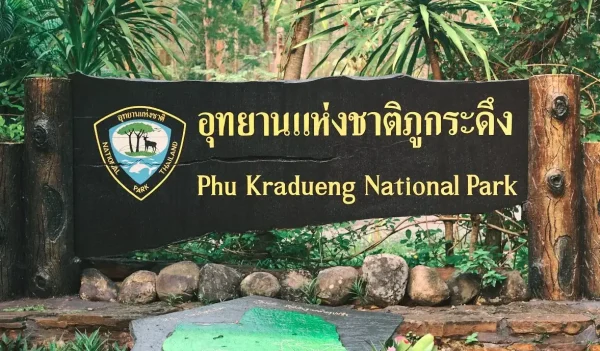
It covers an area of 348 km2 and is home to a variety of ecosystems, including rainforests, grasslands and waterfalls. The park is famous for its sandstone plateau, which rises to around 1300 meters above sea level and offers panoramic views of the surrounding mountains. The park is also a place of pilgrimage for Buddhists, who come to meditate and make offerings. Phu Kradueng National Park is an ideal destination for nature lovers, who can enjoy hiking, camping, bird watching and photography.
Entrance fee for a foreigner: 400 THB per adult and 200 THB per child.
- Huai Krating Reservoir
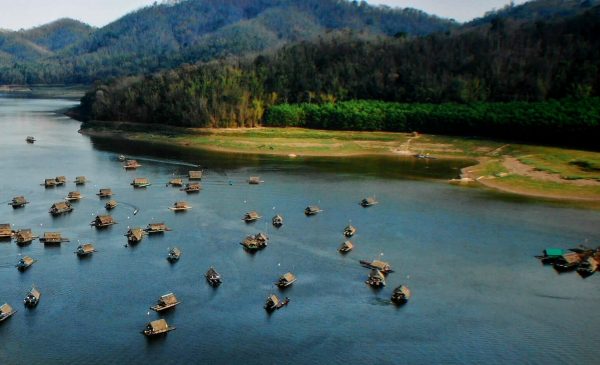
If you’re looking for a great place to eat by the water, look no further than Huai Krating Reservoir. This artificial lake is surrounded by green hills and floating rafts where you can enjoy delicious and authentic Thai cuisine. You can even rent a private raft with a barbecue and grill your own fresh fish. Huai Krating Reservoir is a place of relaxation and fun for the whole family or friends.
- Wat Tham Pha Pu
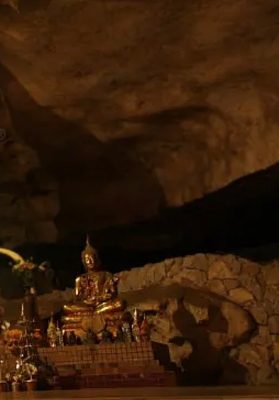
Wat Tham Pha Pu temple is a beautiful and peaceful place to visit in Chiang Khan. It is located on a hill which offers a splendid view of the Mekong River and Laos. The temple is built in the shape of a square, with stairs at each cardinal point, and houses statues of Buddha and revered monks. It is a great place to meditate, pray and admire nature.
The temple is open every day and entry is free.
- The traditional town of Chiang Khan. 😍 Favorite destination 😍
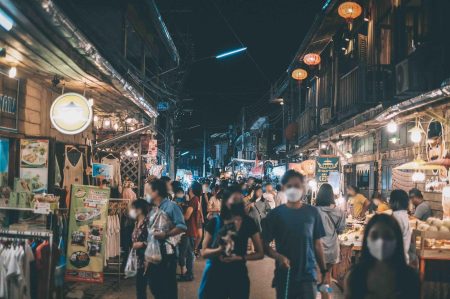

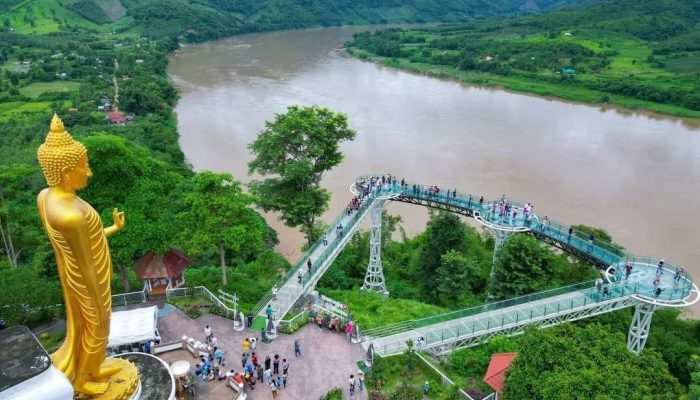
The town of Chiang Khan is a true gem of northeastern Thailand. Located on the banks of the Mekong, it offers a peaceful and authentic atmosphere, far from mass tourism. Its wooden houses, picturesque streets and colorful temples invite you to stroll and explore. You can also enjoy the surrounding nature, by taking a bike ride along the river, visiting the surrounding waterfalls and caves, or admiring the sunrise over the mountains of Laos. Chiang Khan is an ideal destination for those looking to recharge their batteries and enjoy a unique cultural experience.
Bueng Khan province
Bueng Khan Province is a province in northeastern Thailand, created in 2011 from nine districts of Nong Khai Province. It is located on the right bank of the Mekong, which marks the border with Laos. The province has around 400,000 inhabitants and its capital is the city of Bueng Khan. Here I will present to you the most spectacular attraction of this small province…
- Le Wat Phu Tok
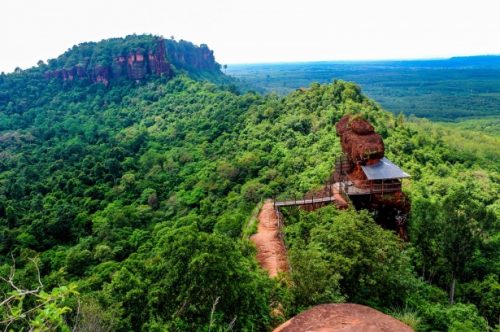
Wat Jetiyakhiri is the official name of the temple, although the most commonly used name is Wat Phu Tok (วัดภูทอก), Phu Tok being the local Isaan name for the mountain and Wat meaning temple.
Wat Phu Tok is arguably the best tourist attraction in the area, although it is actually in the province of Bueng Kan, northeast of Udon Thani, and it is truly beautiful. It is located about three to four hours east of Nong Khai (40 minutes from Udon Thani by car).
It takes about 2 hours at an average pace, but I stopped to take lots of photos and videos along the way. Give yourself 2 hours to enjoy it.
Wear appropriate clothing – even though it is a trek, it is a temple, wear long pants and sleeved shirts, good shoes are also advised for trekking.
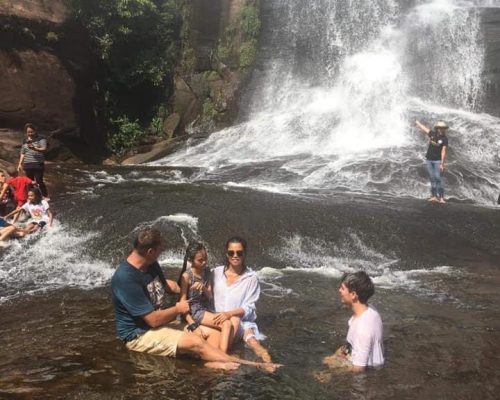
Udon Thani province, Nong Khai and surrounding areas
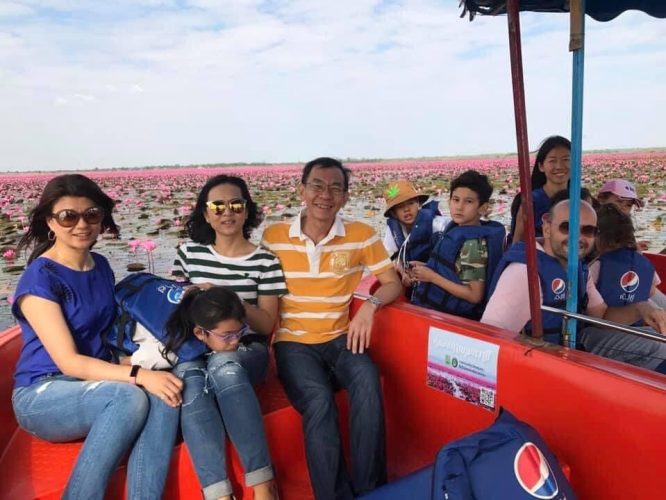
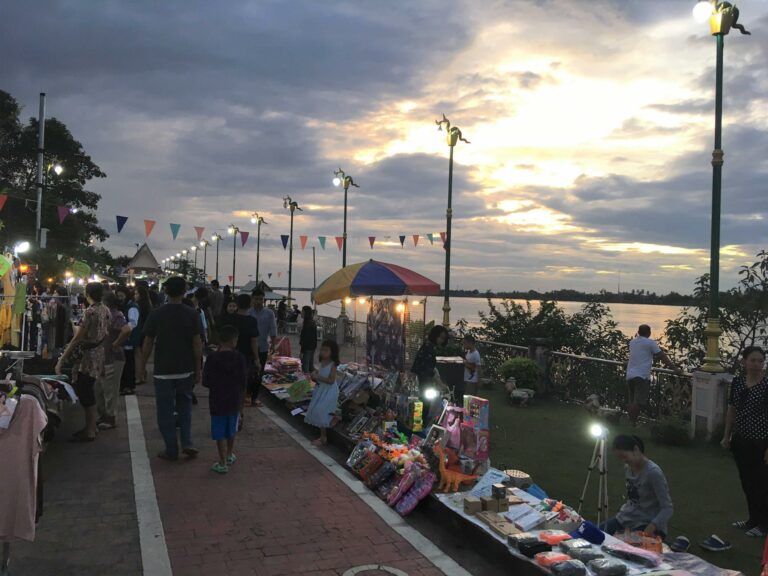
- Udon Thani Province is a province in northeastern Thailand, located approximately 560 kilometers from Bangkok. It is part of the historical and cultural region of Isan, which is influenced by neighboring Laos. Udon Thani province is known for its archaeological sites, nature parks, Buddhist temples and spicy cuisine. The provincial capital, also called Udon Thani, is a bustling city with markets, museums, shopping centers and a varied nightlife.
Nong Khai Province is a province in northeastern Thailand, located along the Mekong River. It is known for its natural landscapes, its Buddhist temples and its Friendship Bridge which connects it to Laos. Nong Khai Province is also home to Phra That Nong Khai Historical Park, home to a large golden stupa dating back to the 16th century. The provincial capital is the town of Nong Khai, which offers panoramic views of the river and the neighboring city of Vientiane.
Nakhon Phanom province
Located on the banks of the Mekong, it offers magnificent landscapes, ancient temples and traditional villages. There you can discover the richness of local heritage, such as the giant candle festival, the night market or the President Ho Chi Minh museum. Feel free to venture into the surrounding mountains, where you can admire spectacular waterfalls, caves and rock formations.
- Wat Phra That Phanom
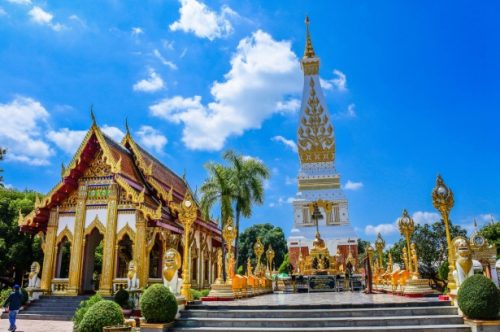
Wat Phra That Phanom Woramahawihan is a jewel of Thailand’s Buddhist heritage. Located in That Phanom district in the south of Nakhon Phanom province, this temple houses a relic of the Buddha’s breast, said to have been brought from India by the monk Maha Kassapa, one of the Buddha’s chief disciples. The temple has been revered for millennia by the multi-ethnic and multinational populations of the Mekong region. The temple’s stupa, 57 meters high, is decorated with Laotian and Khmer motifs, witnesses to the cultural influences that have marked its history. The stupa was restored in 1979 after collapsing in the rain, and revealed a series of gold caskets containing the precious relic. Wat Phra That Phanom is a place of pilgrimage and celebration for Buddhists, especially those born under the sign of the monkey. It is also a place of beauty and serenity, where you can admire paintings illustrating Thai proverbs and the surrounding landscapes.
- Ho Chi Minh museum
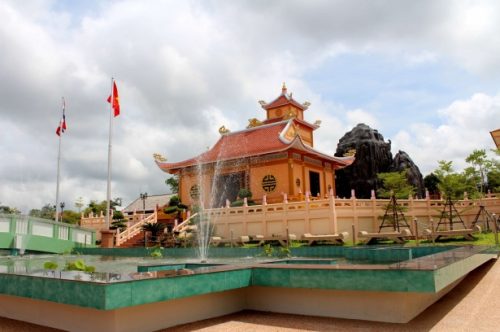
If you are interested in the history of Vietnam and its revolutionary leader Hồ Chí Minh, you can visit the museum dedicated to him in Nakhon Phanon, Thailand. This museum traces the life and travels of Uncle Hồ, who stayed in this region in the 1920s. You can see his statue, his wooden house, his photos and his writings. It is a place of memory and friendship between the Thai and Vietnamese people.
- The night market
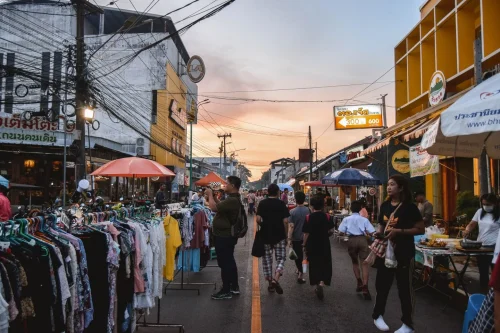
I love Nakhon Phanon and its night market! It’s a magical place where you can find everything: delicious dishes, original souvenirs, captivating shows. The night market is an unforgettable experience for the senses. You feel immersed in the culture and atmosphere of Thailand. I highly recommend visiting Nakhon Phanon Night Market if you get the chance!
- Ubon Ratchathani province
Ubon Ratchathani province is a fascinating region in the northeast of Thailand, also called Isan. It is known for its cultural richness, its natural landscapes and its candle festival. It shares its borders with Cambodia and Laos, forming part of the Emerald Triangle. Its capital, Ubon Ratchathani, is a lively and modern city, home to many Buddhist temples, including the famous Wat Phra That Nong Bua.
- Wat Phra That Nong Bua
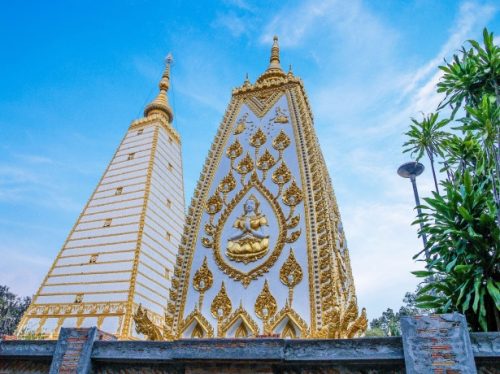
Wat Phra That Nong Bua is a beautiful and sacred temple located in Ubon Ratchathani, northeastern Thailand. It is a place of worship and pilgrimage for Buddhists, as it houses a relic of the Buddha and an impressive Indian-style chedi. The chedi, built in 1956, is 56 meters high and decorated with gold and marble. It commemorates the 25th centenary of the birth of Buddhism and is inspired by the Mahabodhi of Bodh-Gaya, the place where the Buddha achieved enlightenment. The temple is also decorated with beautiful sculptures and paintings depicting scenes from the life of the Buddha and the Dharma. Wat Phra That Nong Bua is an architectural and spiritual gem that is worth a visit if you visit Ubon Ratchathani.
- Pha Taem
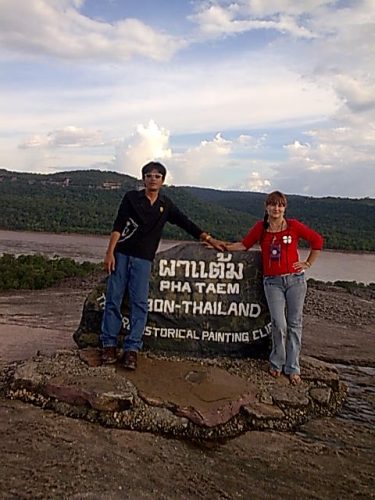
Pha Taem is a fascinating prehistoric site located in northeastern Thailand, near the border with Laos. It houses more than 300 cave paintings dating back 3,000 to 4,000 years, depicting animals, humans and scenes from daily life. Pha taem also offers spectacular views of the Mekong and surrounding mountains. It is an ideal place for lovers of history, nature and culture.
- Maenam Song Si Viewpoint
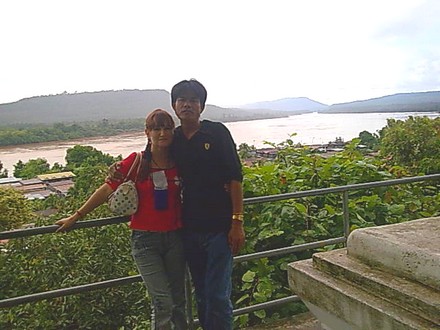
Maenam Song Si is a spectacular natural phenomenon that occurs in Ubon Ratchathani, a province in the northeast of Thailand. This is where two rivers, the Mun and the Chi, meet and mix to form the Mekong. Mun is dark brown in color due to the reddish soil it carries, while Chi is light green in color due to the algae it contains. When the two rivers come together, they create a striking contrast of colors that resembles an abstract painting. Maenam Song Si literally means “two-colored river” in Thai. It is a popular tourist attraction that attracts many visitors each year, especially during the dry season when the water level is low and the colors are more visible. Maenam Song Si is a great place to admire the beauty of nature and learn the history and culture of the Ubon Ratchathani region.
Sisaket province
Sisaket province is a wonderful destination for nature and culture lovers. Located in the northeast of Thailand, it offers varied landscapes, ancient temples and colorful festivals. There you can discover the Khao Phra Wihan National Park, which is home to a Khmer archaeological site classified as a UNESCO World Heritage Site, and the famous Temple of a Thousand Bottles…
- Khao Phra Wihan National Park
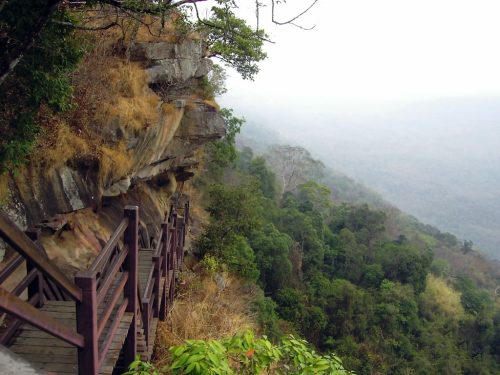
Khao Phra Wihan National Park is a protected natural area located in Sisaket Province, Thailand. It is home to many remains of the 11th century Khmer Empire, including the famous Prasat Khao Phra Wihan temple, which sits on the border with Cambodia. The park is located 98 km south of the town of Sisaket, at the end of road 221. It is perched on a red cliff which is part of the Dângrêk range, south of the Khorat plateau. The park was created in 1998 and covers an area of 130 km2. It offers spectacular views of the surrounding landscape and the Khmer temple, which has been a UNESCO World Heritage Site since 2008. The park is generally open to the public for an entrance fee, unless there is tension between the two country.
- Wat Lan Khuad

It was constructed from over a million recycled glass bottles, which were used to decorate the walls, roofs, statues and even the floor. The temple was established by local Buddhist monks, who began collecting the bottles in 1984. The aim of the project was to raise awareness about environmental protection and waste reduction. The Sisaket Thousand Bottle Temple is an example of ecological art and spiritual creativity.
La province de Surin
La province de Surin est une province du nord-est de la Thaïlande, située à la frontière avec le Cambodge. Elle fait partie de la région historique et culturelle de l’Isan, qui est influencée par la langue et la religion khmères. La province de Surin est connue pour son festival annuel des éléphants, qui attire des milliers de visiteurs chaque année. La province abrite également plusieurs sites archéologiques.
BUT…
They are tall and majestic
These elephants from Thailand
Who march in harmonious ranks
Under the gaze of tourists in demand…
But behind this parade
A cruel reality hides
These animals are trained by fear and pain
To obey the orders of the unscrupulous mahouts
They suffer blows, chains, hooks
They lose their freedom, their dignity, their family
They become machines to entertain and work
At the cost of their health, their happiness, their lives
Let us not be complicit in this exploitation
Let us refuse to participate in these inhumane spectacles
Let’s support associations that protect elephants
And let’s respect their nature, their space, their destiny 🙏🙏🙏
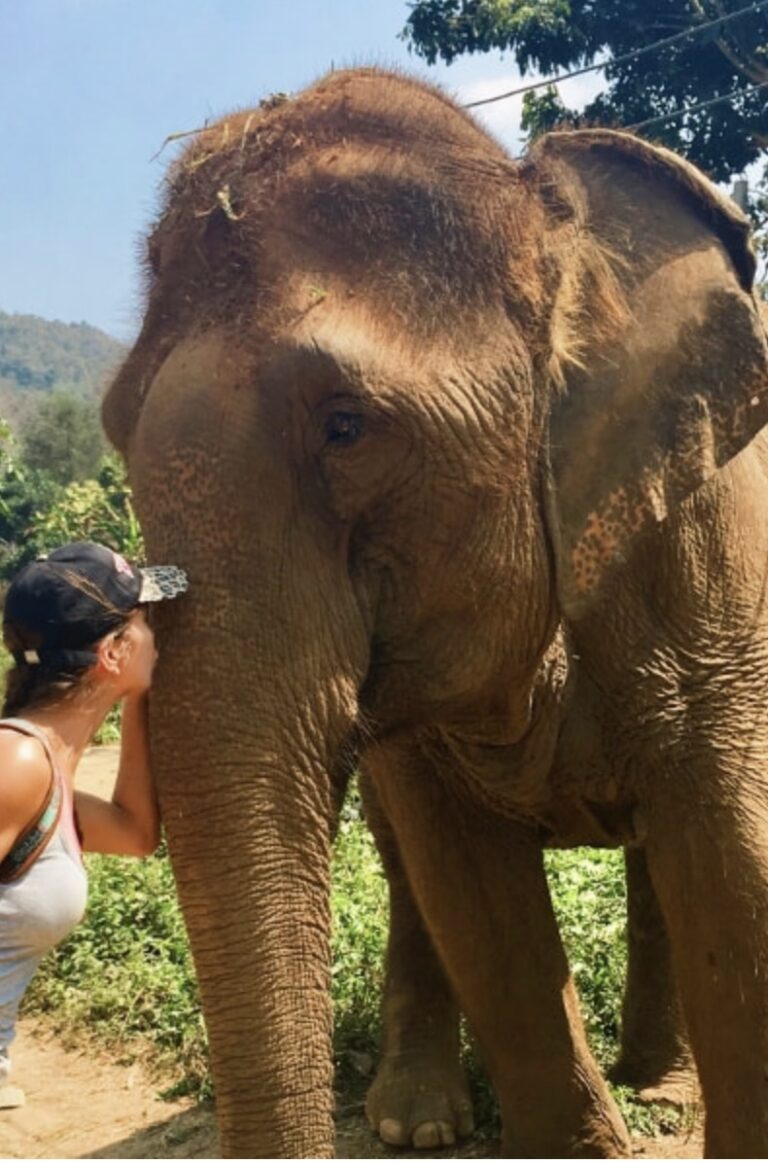
Share this:
Articles similaires
Discover more from Woofing in Thailand
Subscribe to get the latest posts sent to your email.
